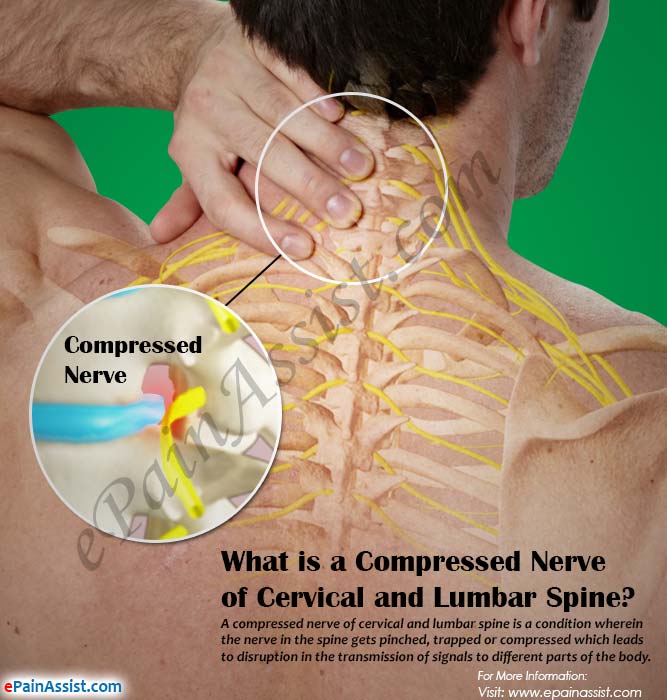The brain and spinal cord are connected to the body through complex network of nerves. It consists of the central nervous system nerves and peripheral nerves. These nerves carry signals or messages from the brain and spinal cord to different parts of the body. This causes movement of the muscles and gives a sensory feel to the skin. The nerves run through the spinal cord. Many a times due to various reasons, a nerve can get compressed or pinched leading to various signs and symptoms and discomforts like pain, irritation and tingling. Let us know what happens if you have a compressed nerve of the cervical and lumbar spine and the various signs of compressed nerves in the spine, so that they can be identified at once and proper treatment can be taken at the right time.
The Anatomy of Cervical and Lumbar Spine and the Nerves
The spinal cord is made of 31 vertebrae, which are stacked on top of each other. These vertebrae are divided into 5 segments each containing a certain number of vertebrae. The 5 segments and the number of vertebrae in each segment of spine are: 8 Cervical spine segments, 12 Thoracic spine segments, Lumbar spine having 5 segments, Sacral spine containing 5 vertebrae fused into one and one Coccyx segment. From each of the segment, respective nerves originate to serve different parts of the body. All the nerves exit the spinal column through the Intervertebral Foramen below the corresponding vertebra except the C1 and C2 nerves originating from the C1 and C2 cervical spine segment respectively. C1 nerve exit the spinal column through the occiput and C1 vertebra; while C2 nerves exit the spinal column through the posterior arch of C1 vertebra and the lamina of C2 vertebra. Upper and lower limbs being the most mobile and flexible parts of the body are served by cervical nerves and lumbar nerves respectively. Problems in these nerves can cause various symptoms in the limbs. The cervical nerves also supply the shoulders, neck and diaphragm.

What is a Compressed Nerve of Cervical and Lumbar Spine?
A compressed nerve of cervical and lumbar spine is a condition wherein the nerve in the spine gets pinched, trapped or compressed, which leads to disruption in the transmission of signals to different parts of the body. This results in pain and other signs and symptoms. Nerve compression is usually caused by pressure over the nerve from the surrounding tissues. It can be a result of traumatic injury, spondylolisthesis, spinal stenosis, repetitive strain injury, herniated intervertebral disc, degenerative disc disease, spondylosis, osteoarthritis, incorrect posture etc.
What Happens If You Have Compressed Nerve of the Cervical and Lumbar Spine?
The common signs and symptoms of compressed nerve of the cervical and lumbar spine include:
- Signs and Symptoms of Compressed Nerve of Cervical Spine: If you have compressed nerve of the cervical spine, then you may experience –
- Pain in the neck where compression has occurred.
- Loss of sensation in the neck over the affected area.
- Tingling and numbness in the neck, shoulder, arms and hands.
- Weak muscles of the neck, shoulder and arms. This can lead to problems like inability to carry any objects.
- Radiating pain in the shoulder, arms and hands.
- Numbness in the wrist and along the thumb.
- Compressed cervical spine nerve at C1, C2 or C3 level can also lead to headache.
- Compressed C4 cervical spine nerve can lead to problems with shoulder movement and diaphragm.
- When the symptoms worsen, movements such as turning the head or moving the neck will lead to pain.
- Signs of Compressed Nerve of Lumbar Spine: If you have compressed nerve of the cervical spine, then you may experience –
- Pain in the affected lumbar spine area.
- Loss of sensation of the affected area.
- Numbness and tingling sensation in the affected area and also towards the lower limb.
- Weakened muscles around the lumbar spine, lower back and legs.
- Radiating pain towards the leg similar like sciatica or radicular pain.
- If there is compression of the lumbar spine nerves at L1-L4 level, then there could be difficulties and pain experienced while flexing and abducting the legs.
- If L5 nerves are compressed, pain and discomfort is experienced during extending the leg from the hip joint and while flexing and extending the foot.
- Under severe circumstances or if proper treatment is taken at the right time, lumbar nerve compression can lead to complete loss of sensation and hence mobility will be affected.
Risk Factors of Compressed Nerve of Cervical and Lumbar Spine
- Weight: An obese individual finds it difficult to manage balance which can lead to fall. The injury may cause compression of the nerve in the cervical and lumbar region of the spine.
- Age as a Risk Factor of Nerve Compression: An increase in age leads to degeneration of the vertebrae, which leads to entrapment of nerves and different medical conditions.
- Nature of Work: Some work is of repetitive nature (sewing of clothes) while some work is of strenuous nature (carrying heavy material on the back). Both the kinds of jobs can lead to repetitive strain injury resulting in nerve compression of the cervical and lumbar spine.
Conclusion
Compression of cervical and lumbar spine nerve can be caused due to various reasons. In order to treat it well, the exact cause of this problem needs to be diagnosed. In mild cases of nerve entrapment, conservative treatment strategies will provide relief. While in case of chronic and persistent nerve compression symptoms, surgery may be beneficial or else the nerve damage may persist permanently. Hence, it is always better to prevent occurrence of such nerve compression by following a healthy lifestyle and by seeking medical attention as soon as signs of nerve compression is observed.
